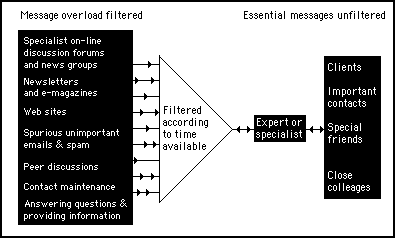
Chapter 15
Communication strategy
Message capacity limitations
The concept of small-world clustering is a useful way of viewing the information environment. It neatly explains how information can propagate around the Internet and also impinge upon the non connected world. However, the simplicity of this model is deceiving, because it also seems to suggest that anyone can easily connect up to anyone else on the Internet - making it possible to access the expert opinion of anyone in the world, simply through the process of asking a friend to ask a friend.
In practice, it isn't this easy, because humans have a limited capacity for receiving and sending messages. For example, it may seem a nice idea that you could connect up through just a few links to the President of the United States, but, millions of others might have the same idea. Lines linking directly to the President would have to be drastically filtered and so too would the connecting links through several steps around him.
This same problem, in varying degrees, would apply to almost everyone connected to the Internet. Straight forward connections will not always be a possibility. Everyone will represent a node with a limited bandwidth (maximum ability to deal with messages) and be forced to apply some kind of selection or filtering strategy to deal with message overloading.
This would apply particularly to people who are valuable contacts. They will have lots of people trying to get their attention and all links to them will be heavily congested and have to be highly filtered. What this means in practice is that although there is a theoretical short number of steps between people connected to the Internet, bandwidth limitations restrict the number of communications that can pass through the shortest route.
Figure 15.1 illustrates the kind of electronic message flows that experts or specialists (as an example) have to deal with on a daily basis. They will have clients, important contacts, special friends and close colleagues whose communications must be given priority. Over and above this, the experts and specialists will need to be kept up to date with what is happening in their field and be able to learn or acquire new information and knowledge. Typically, this will result in an overload of information that will have to be filtered according to available time.

Figure 15.1
Typical electronic information load for experts and specialists who are connected to the Internet
Clearly, if this is the typical way in which people deal with messages, it is important to make contacts through the links listed on the right hand side of figure 15.1. This would need to be arranged by means of an appropriate communication strategy, as any casual communications would be subject to filtering